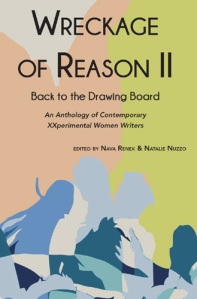I am happy to have an excerpt from my blog, “all about love, nearly,” in this excellent new anthology published by Spuyten Duyvil Press: Wreckage of Reason II: Back to the Drawing Board — a collection of experimental women’s fiction.
You can listen to an excerpt here:
https://www.youtube.com/watch?v=tpCJf6ft9d8&feature=youtu.be
“How to explain that the betrayal is of another sort altogether? I know the tidal pull of the blood; that a mere glance can send plumes of fire curling through the nerves. After J. arrived: the sudden, mind-controlling molecular saturation of pheromones in the air, a maddening inability to concentrate, to think of anything at all. Intoxication, situational insanity, delusion. An attraction so fierce it made me angry; the almost violent force required to resist it. Focus on what you don’t like—it’s all there, right in the very first moment. Just take a look back and you can see it clear as day: the sober assessment, the critical points like elephants weighing down the wrong side of the scale, and then the sticky-sweet goo of self-deception oozing all over it like an egg cracked atop a skull, the giddy, hypnotic, honeyed brilliance of it—ah, love! How blind does it have to be to erase that immediate recognition of disaster? Men have their siren song to lead them astray, but what about us?”
— from the blog “Stories I tell myself before I go to sleep at night,” April 2014.
Published in “Wreckage of Reason II: Back to the Drawing Board,” an anthology of experimental women’s fiction (eds. Nava Renek, Natalie Nuzzo, Spuyten Duyvil Press).
http://www.spuytenduyvil.net/worii.html
“The range of the stories in this volume of Wreckage of Reason II is vast and far-reaching. There are thirty-three selections, among which are playfully reconstituted myths and fairy tales, experimental flash fiction, and sexually pungent satires that are presented alongside powerful stories about violence and loss, mothers and daughters, lovers and spouses, political horrors and existential loneliness, erotic visions and happenings. Each of them seemed to come from a commitment to literary risk, exploration, and playfulness and a tacit disregard of marketability. For that, the selections are unusually wrought, evincing precisely articulated literary intentions. Space will not allow me to include each and every one of them, yet each was unusual and lively, a truth on its own twirling axis.”
— Leora Skolkin-Smith
In this follow-up to the 2008 bestselling Wreckage of Reason: An Anthology of Experimental Prose by Contemporary Women Writers, 29 contributors use different styles and language genres, their tools at hand, to illustrate moments of conflict, amusement, bafflement and joy that make up a day, a year, an individual life or a collective history. Held up to the light or inspected under a microscope, set in locales real, virtual, mythic, and imaginary, characters bump into and move through events, leaving readers with the humorous, sad, sexy and playful ambiguities of what it means to be alive. This anthology provides a much needed venue to spotlight women writers engaged in serious creative writing projects chronicling and responding to our current culture.
“Were this book published by St. Martin’s or Norton, they would have slapped its contents on wider margins and packaged it for the college market at twice the cost. Except Norton or St. Martin’s would never publish this book—it’s too dangerous, wild, and singular. Wreckage of Reason gives us three dozen women authors beyond any easily marketable definition; by any description, it’s an anthology worthy of an audience and acclaim.”
— Ted Pelton, The Brooklyn Rail (writing about Wreckage of Reason I)

